MKG721 Industry Analysis: Challenges & Opportunities in AU Food
VerifiedAdded on 2023/06/10
|10
|1791
|60
Report
AI Summary
This report examines the emerging food industry sector in Australia, focusing on its challenges and opportunities. Using Porter's Five Forces model, it assesses the competitive landscape, highlighting the high competitive rivalry and strong threat from substitutes and new entrants. The analysis reveals that while the organic food sector has significant growth potential due to increasing consumer awareness of health and environmental issues, it also faces threats such as a lack of consumer education and awareness regarding organic products. The report concludes that the emerging sector should prioritize customer concerns, enforce stricter quality regulations, expand its supply chain, and diversify its suppliers to mitigate risks and capitalize on opportunities within the Australian food industry. Desklib provides access to this and other solved assignments for students.
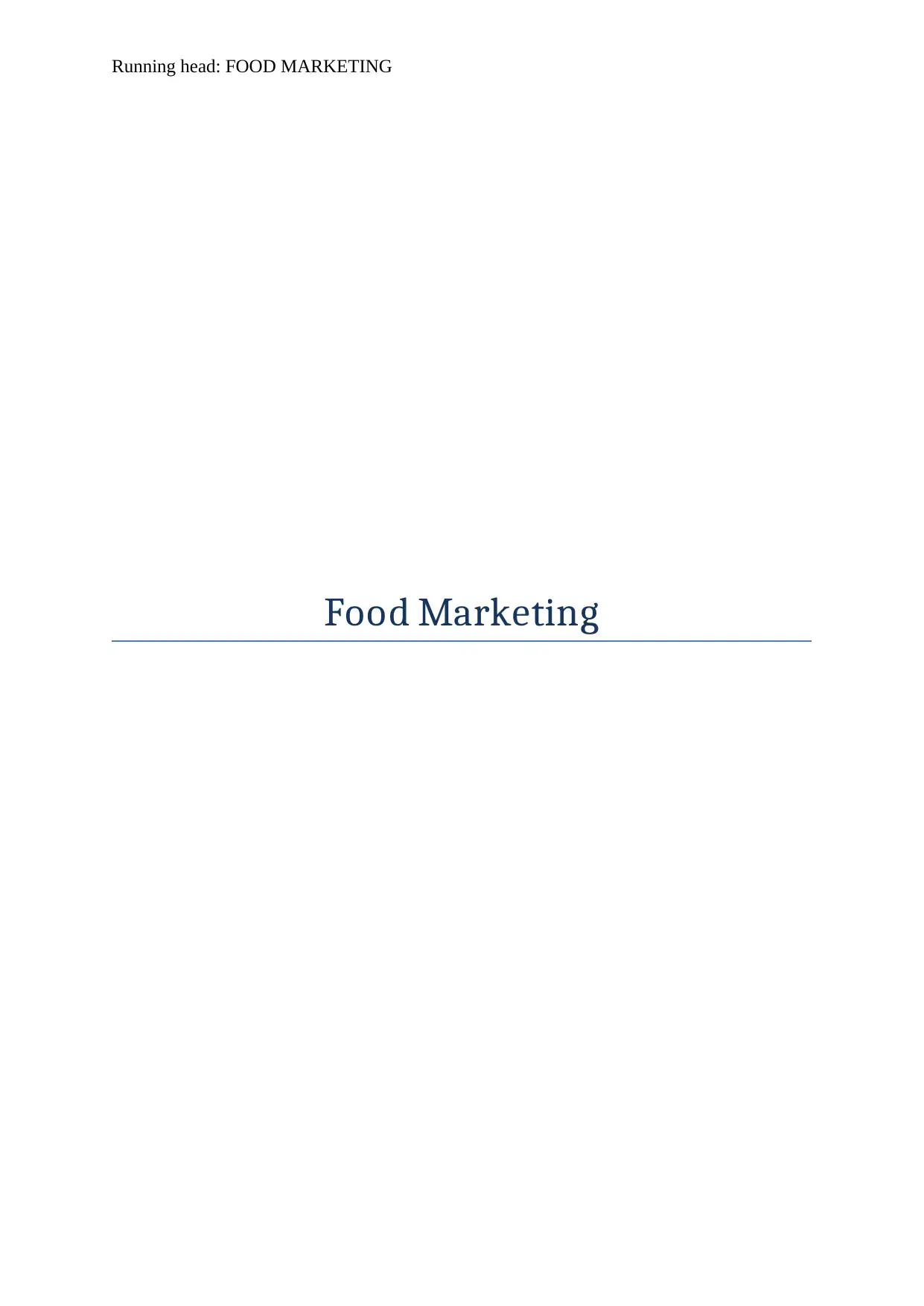
Running head: FOOD MARKETING
Food Marketing
Food Marketing
Paraphrase This Document
Need a fresh take? Get an instant paraphrase of this document with our AI Paraphraser
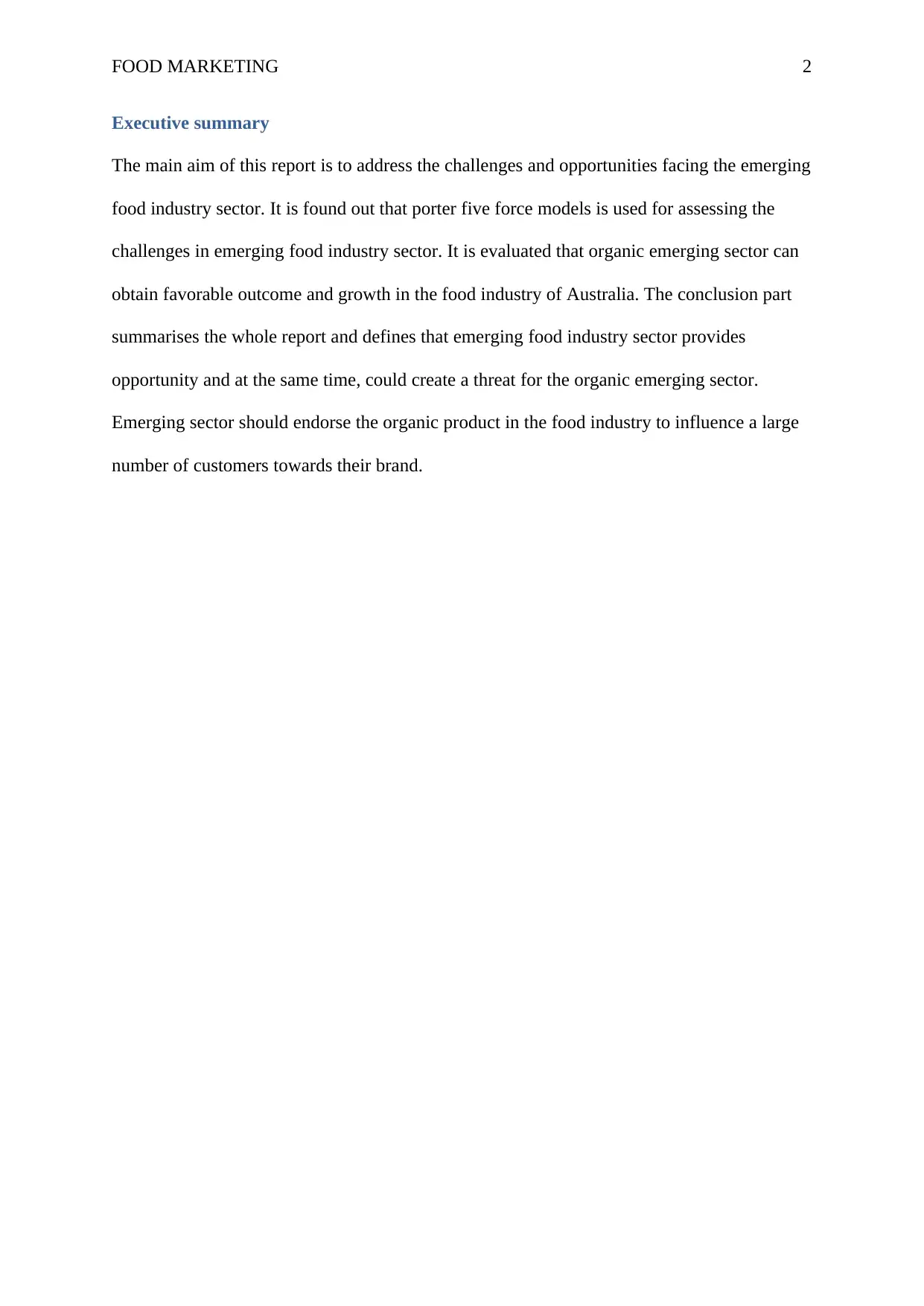
FOOD MARKETING 2
Executive summary
The main aim of this report is to address the challenges and opportunities facing the emerging
food industry sector. It is found out that porter five force models is used for assessing the
challenges in emerging food industry sector. It is evaluated that organic emerging sector can
obtain favorable outcome and growth in the food industry of Australia. The conclusion part
summarises the whole report and defines that emerging food industry sector provides
opportunity and at the same time, could create a threat for the organic emerging sector.
Emerging sector should endorse the organic product in the food industry to influence a large
number of customers towards their brand.
Executive summary
The main aim of this report is to address the challenges and opportunities facing the emerging
food industry sector. It is found out that porter five force models is used for assessing the
challenges in emerging food industry sector. It is evaluated that organic emerging sector can
obtain favorable outcome and growth in the food industry of Australia. The conclusion part
summarises the whole report and defines that emerging food industry sector provides
opportunity and at the same time, could create a threat for the organic emerging sector.
Emerging sector should endorse the organic product in the food industry to influence a large
number of customers towards their brand.
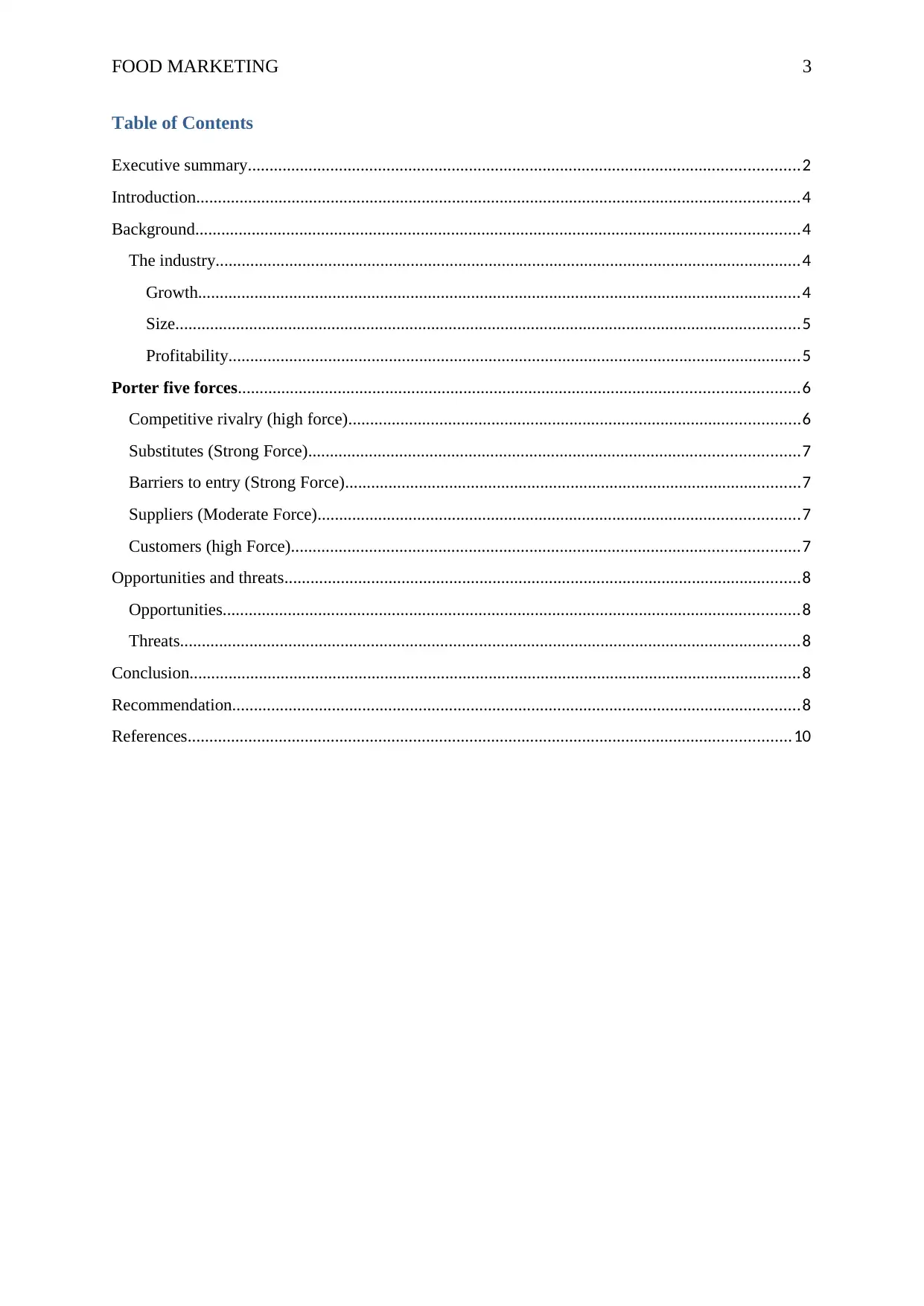
FOOD MARKETING 3
Table of Contents
Executive summary...............................................................................................................................2
Introduction...........................................................................................................................................4
Background...........................................................................................................................................4
The industry.......................................................................................................................................4
Growth...........................................................................................................................................4
Size................................................................................................................................................5
Profitability....................................................................................................................................5
Porter five forces.................................................................................................................................6
Competitive rivalry (high force)........................................................................................................6
Substitutes (Strong Force).................................................................................................................7
Barriers to entry (Strong Force).........................................................................................................7
Suppliers (Moderate Force)...............................................................................................................7
Customers (high Force).....................................................................................................................7
Opportunities and threats.......................................................................................................................8
Opportunities.....................................................................................................................................8
Threats...............................................................................................................................................8
Conclusion.............................................................................................................................................8
Recommendation...................................................................................................................................8
References...........................................................................................................................................10
Table of Contents
Executive summary...............................................................................................................................2
Introduction...........................................................................................................................................4
Background...........................................................................................................................................4
The industry.......................................................................................................................................4
Growth...........................................................................................................................................4
Size................................................................................................................................................5
Profitability....................................................................................................................................5
Porter five forces.................................................................................................................................6
Competitive rivalry (high force)........................................................................................................6
Substitutes (Strong Force).................................................................................................................7
Barriers to entry (Strong Force).........................................................................................................7
Suppliers (Moderate Force)...............................................................................................................7
Customers (high Force).....................................................................................................................7
Opportunities and threats.......................................................................................................................8
Opportunities.....................................................................................................................................8
Threats...............................................................................................................................................8
Conclusion.............................................................................................................................................8
Recommendation...................................................................................................................................8
References...........................................................................................................................................10
You're viewing a preview
Unlock full access by subscribing today!
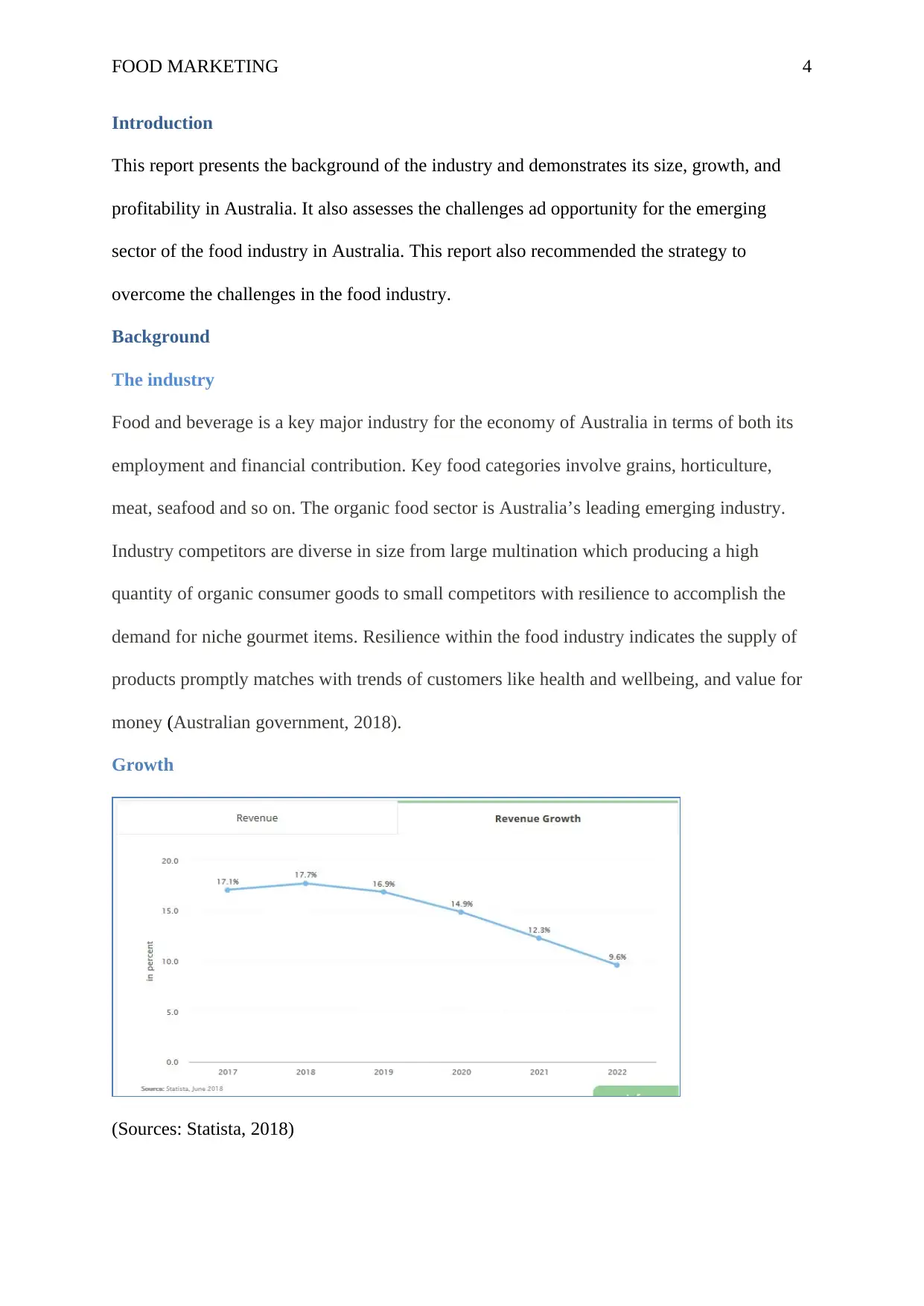
FOOD MARKETING 4
Introduction
This report presents the background of the industry and demonstrates its size, growth, and
profitability in Australia. It also assesses the challenges ad opportunity for the emerging
sector of the food industry in Australia. This report also recommended the strategy to
overcome the challenges in the food industry.
Background
The industry
Food and beverage is a key major industry for the economy of Australia in terms of both its
employment and financial contribution. Key food categories involve grains, horticulture,
meat, seafood and so on. The organic food sector is Australia’s leading emerging industry.
Industry competitors are diverse in size from large multination which producing a high
quantity of organic consumer goods to small competitors with resilience to accomplish the
demand for niche gourmet items. Resilience within the food industry indicates the supply of
products promptly matches with trends of customers like health and wellbeing, and value for
money (Australian government, 2018).
Growth
(Sources: Statista, 2018)
Introduction
This report presents the background of the industry and demonstrates its size, growth, and
profitability in Australia. It also assesses the challenges ad opportunity for the emerging
sector of the food industry in Australia. This report also recommended the strategy to
overcome the challenges in the food industry.
Background
The industry
Food and beverage is a key major industry for the economy of Australia in terms of both its
employment and financial contribution. Key food categories involve grains, horticulture,
meat, seafood and so on. The organic food sector is Australia’s leading emerging industry.
Industry competitors are diverse in size from large multination which producing a high
quantity of organic consumer goods to small competitors with resilience to accomplish the
demand for niche gourmet items. Resilience within the food industry indicates the supply of
products promptly matches with trends of customers like health and wellbeing, and value for
money (Australian government, 2018).
Growth
(Sources: Statista, 2018)
Paraphrase This Document
Need a fresh take? Get an instant paraphrase of this document with our AI Paraphraser
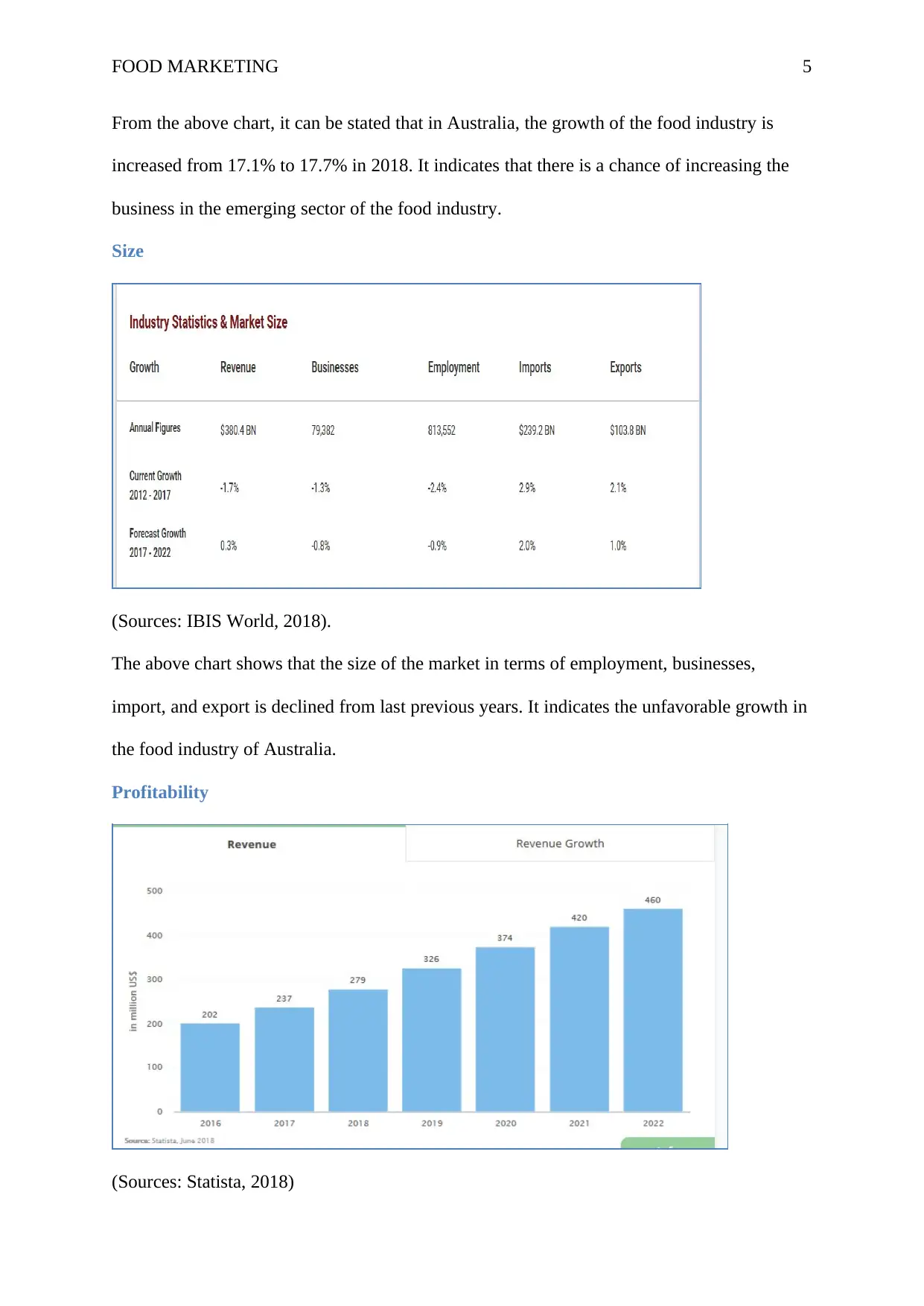
FOOD MARKETING 5
From the above chart, it can be stated that in Australia, the growth of the food industry is
increased from 17.1% to 17.7% in 2018. It indicates that there is a chance of increasing the
business in the emerging sector of the food industry.
Size
(Sources: IBIS World, 2018).
The above chart shows that the size of the market in terms of employment, businesses,
import, and export is declined from last previous years. It indicates the unfavorable growth in
the food industry of Australia.
Profitability
(Sources: Statista, 2018)
From the above chart, it can be stated that in Australia, the growth of the food industry is
increased from 17.1% to 17.7% in 2018. It indicates that there is a chance of increasing the
business in the emerging sector of the food industry.
Size
(Sources: IBIS World, 2018).
The above chart shows that the size of the market in terms of employment, businesses,
import, and export is declined from last previous years. It indicates the unfavorable growth in
the food industry of Australia.
Profitability
(Sources: Statista, 2018)
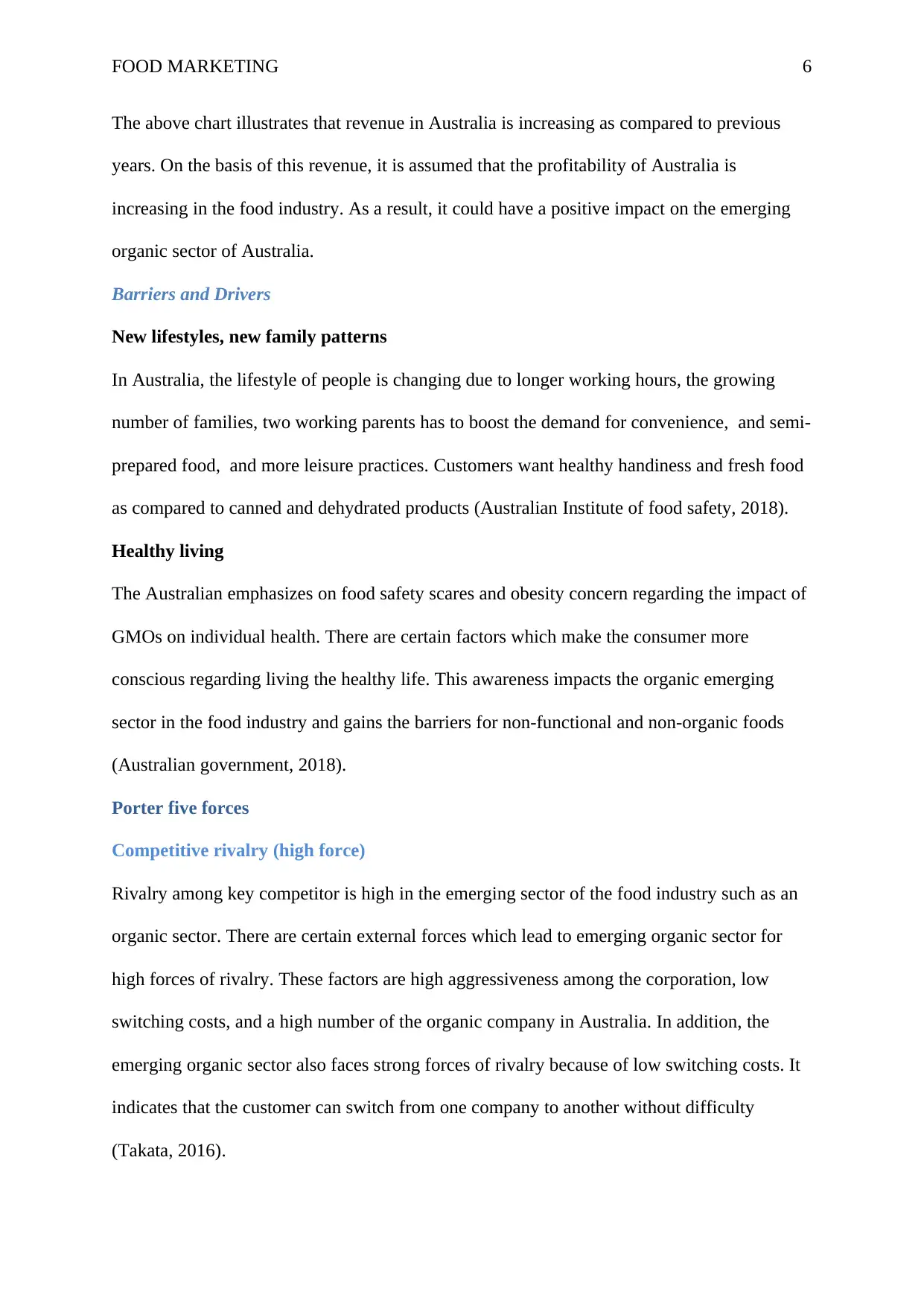
FOOD MARKETING 6
The above chart illustrates that revenue in Australia is increasing as compared to previous
years. On the basis of this revenue, it is assumed that the profitability of Australia is
increasing in the food industry. As a result, it could have a positive impact on the emerging
organic sector of Australia.
Barriers and Drivers
New lifestyles, new family patterns
In Australia, the lifestyle of people is changing due to longer working hours, the growing
number of families, two working parents has to boost the demand for convenience, and semi-
prepared food, and more leisure practices. Customers want healthy handiness and fresh food
as compared to canned and dehydrated products (Australian Institute of food safety, 2018).
Healthy living
The Australian emphasizes on food safety scares and obesity concern regarding the impact of
GMOs on individual health. There are certain factors which make the consumer more
conscious regarding living the healthy life. This awareness impacts the organic emerging
sector in the food industry and gains the barriers for non-functional and non-organic foods
(Australian government, 2018).
Porter five forces
Competitive rivalry (high force)
Rivalry among key competitor is high in the emerging sector of the food industry such as an
organic sector. There are certain external forces which lead to emerging organic sector for
high forces of rivalry. These factors are high aggressiveness among the corporation, low
switching costs, and a high number of the organic company in Australia. In addition, the
emerging organic sector also faces strong forces of rivalry because of low switching costs. It
indicates that the customer can switch from one company to another without difficulty
(Takata, 2016).
The above chart illustrates that revenue in Australia is increasing as compared to previous
years. On the basis of this revenue, it is assumed that the profitability of Australia is
increasing in the food industry. As a result, it could have a positive impact on the emerging
organic sector of Australia.
Barriers and Drivers
New lifestyles, new family patterns
In Australia, the lifestyle of people is changing due to longer working hours, the growing
number of families, two working parents has to boost the demand for convenience, and semi-
prepared food, and more leisure practices. Customers want healthy handiness and fresh food
as compared to canned and dehydrated products (Australian Institute of food safety, 2018).
Healthy living
The Australian emphasizes on food safety scares and obesity concern regarding the impact of
GMOs on individual health. There are certain factors which make the consumer more
conscious regarding living the healthy life. This awareness impacts the organic emerging
sector in the food industry and gains the barriers for non-functional and non-organic foods
(Australian government, 2018).
Porter five forces
Competitive rivalry (high force)
Rivalry among key competitor is high in the emerging sector of the food industry such as an
organic sector. There are certain external forces which lead to emerging organic sector for
high forces of rivalry. These factors are high aggressiveness among the corporation, low
switching costs, and a high number of the organic company in Australia. In addition, the
emerging organic sector also faces strong forces of rivalry because of low switching costs. It
indicates that the customer can switch from one company to another without difficulty
(Takata, 2016).
You're viewing a preview
Unlock full access by subscribing today!
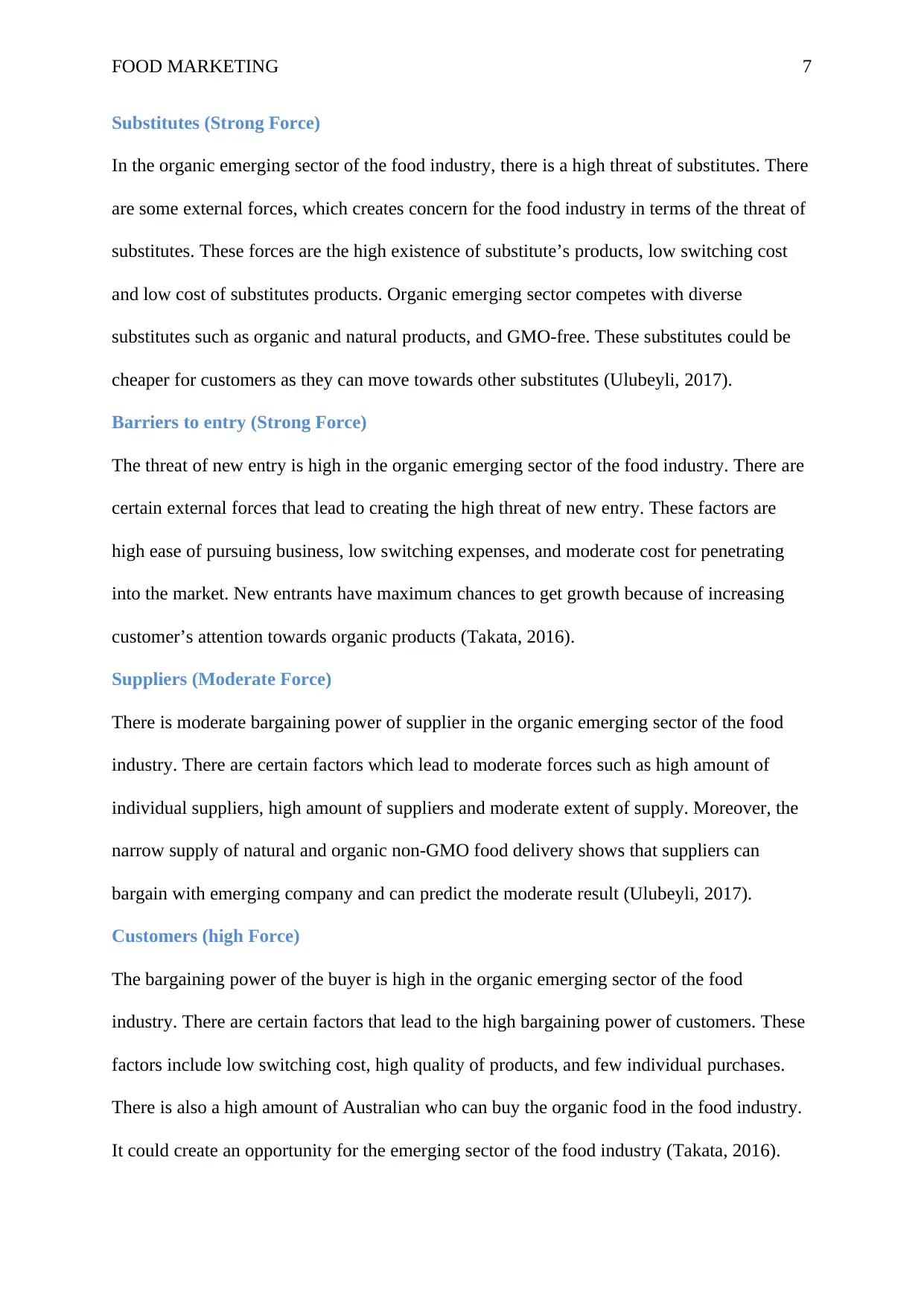
FOOD MARKETING 7
Substitutes (Strong Force)
In the organic emerging sector of the food industry, there is a high threat of substitutes. There
are some external forces, which creates concern for the food industry in terms of the threat of
substitutes. These forces are the high existence of substitute’s products, low switching cost
and low cost of substitutes products. Organic emerging sector competes with diverse
substitutes such as organic and natural products, and GMO-free. These substitutes could be
cheaper for customers as they can move towards other substitutes (Ulubeyli, 2017).
Barriers to entry (Strong Force)
The threat of new entry is high in the organic emerging sector of the food industry. There are
certain external forces that lead to creating the high threat of new entry. These factors are
high ease of pursuing business, low switching expenses, and moderate cost for penetrating
into the market. New entrants have maximum chances to get growth because of increasing
customer’s attention towards organic products (Takata, 2016).
Suppliers (Moderate Force)
There is moderate bargaining power of supplier in the organic emerging sector of the food
industry. There are certain factors which lead to moderate forces such as high amount of
individual suppliers, high amount of suppliers and moderate extent of supply. Moreover, the
narrow supply of natural and organic non-GMO food delivery shows that suppliers can
bargain with emerging company and can predict the moderate result (Ulubeyli, 2017).
Customers (high Force)
The bargaining power of the buyer is high in the organic emerging sector of the food
industry. There are certain factors that lead to the high bargaining power of customers. These
factors include low switching cost, high quality of products, and few individual purchases.
There is also a high amount of Australian who can buy the organic food in the food industry.
It could create an opportunity for the emerging sector of the food industry (Takata, 2016).
Substitutes (Strong Force)
In the organic emerging sector of the food industry, there is a high threat of substitutes. There
are some external forces, which creates concern for the food industry in terms of the threat of
substitutes. These forces are the high existence of substitute’s products, low switching cost
and low cost of substitutes products. Organic emerging sector competes with diverse
substitutes such as organic and natural products, and GMO-free. These substitutes could be
cheaper for customers as they can move towards other substitutes (Ulubeyli, 2017).
Barriers to entry (Strong Force)
The threat of new entry is high in the organic emerging sector of the food industry. There are
certain external forces that lead to creating the high threat of new entry. These factors are
high ease of pursuing business, low switching expenses, and moderate cost for penetrating
into the market. New entrants have maximum chances to get growth because of increasing
customer’s attention towards organic products (Takata, 2016).
Suppliers (Moderate Force)
There is moderate bargaining power of supplier in the organic emerging sector of the food
industry. There are certain factors which lead to moderate forces such as high amount of
individual suppliers, high amount of suppliers and moderate extent of supply. Moreover, the
narrow supply of natural and organic non-GMO food delivery shows that suppliers can
bargain with emerging company and can predict the moderate result (Ulubeyli, 2017).
Customers (high Force)
The bargaining power of the buyer is high in the organic emerging sector of the food
industry. There are certain factors that lead to the high bargaining power of customers. These
factors include low switching cost, high quality of products, and few individual purchases.
There is also a high amount of Australian who can buy the organic food in the food industry.
It could create an opportunity for the emerging sector of the food industry (Takata, 2016).
Paraphrase This Document
Need a fresh take? Get an instant paraphrase of this document with our AI Paraphraser
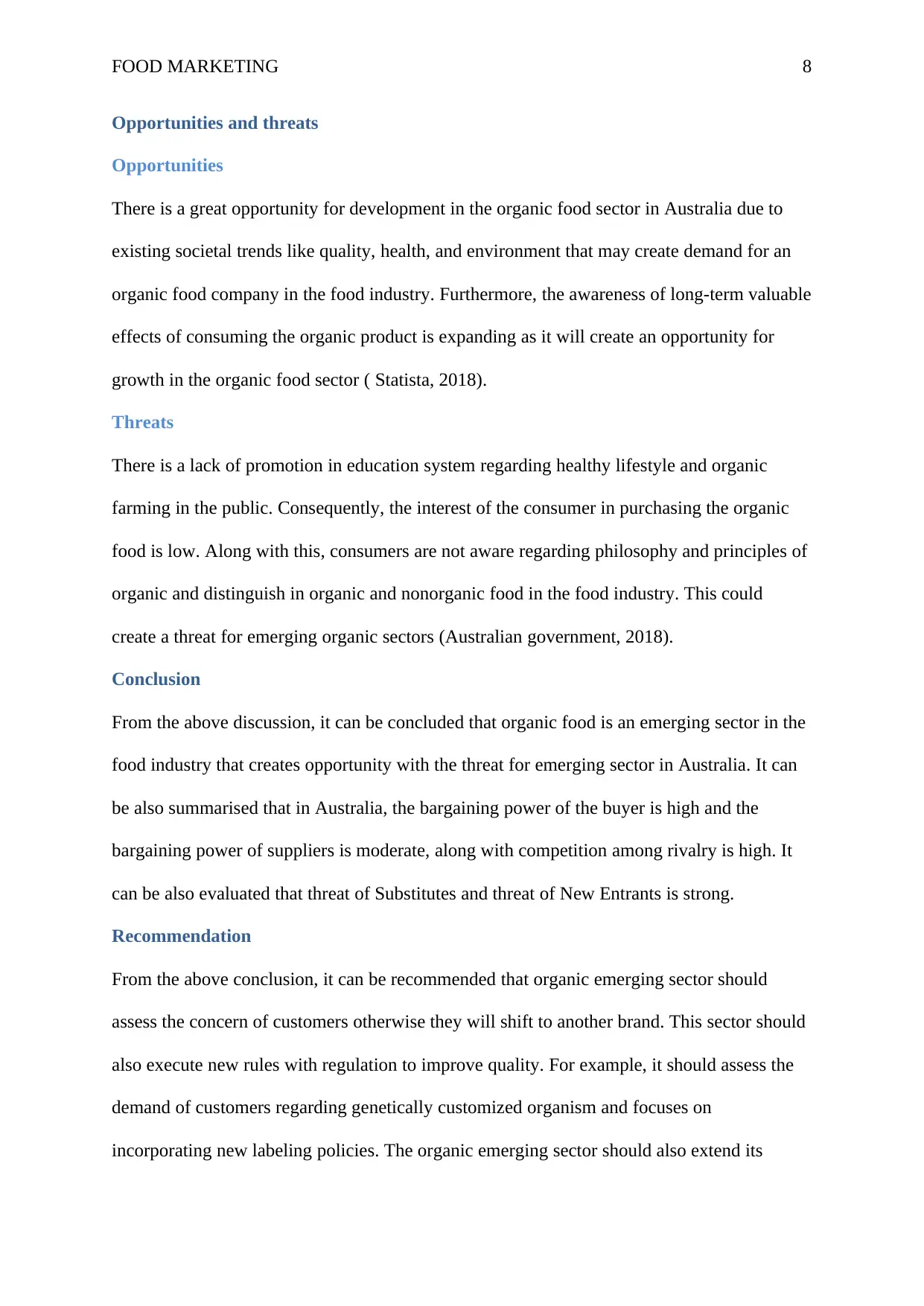
FOOD MARKETING 8
Opportunities and threats
Opportunities
There is a great opportunity for development in the organic food sector in Australia due to
existing societal trends like quality, health, and environment that may create demand for an
organic food company in the food industry. Furthermore, the awareness of long-term valuable
effects of consuming the organic product is expanding as it will create an opportunity for
growth in the organic food sector ( Statista, 2018).
Threats
There is a lack of promotion in education system regarding healthy lifestyle and organic
farming in the public. Consequently, the interest of the consumer in purchasing the organic
food is low. Along with this, consumers are not aware regarding philosophy and principles of
organic and distinguish in organic and nonorganic food in the food industry. This could
create a threat for emerging organic sectors (Australian government, 2018).
Conclusion
From the above discussion, it can be concluded that organic food is an emerging sector in the
food industry that creates opportunity with the threat for emerging sector in Australia. It can
be also summarised that in Australia, the bargaining power of the buyer is high and the
bargaining power of suppliers is moderate, along with competition among rivalry is high. It
can be also evaluated that threat of Substitutes and threat of New Entrants is strong.
Recommendation
From the above conclusion, it can be recommended that organic emerging sector should
assess the concern of customers otherwise they will shift to another brand. This sector should
also execute new rules with regulation to improve quality. For example, it should assess the
demand of customers regarding genetically customized organism and focuses on
incorporating new labeling policies. The organic emerging sector should also extend its
Opportunities and threats
Opportunities
There is a great opportunity for development in the organic food sector in Australia due to
existing societal trends like quality, health, and environment that may create demand for an
organic food company in the food industry. Furthermore, the awareness of long-term valuable
effects of consuming the organic product is expanding as it will create an opportunity for
growth in the organic food sector ( Statista, 2018).
Threats
There is a lack of promotion in education system regarding healthy lifestyle and organic
farming in the public. Consequently, the interest of the consumer in purchasing the organic
food is low. Along with this, consumers are not aware regarding philosophy and principles of
organic and distinguish in organic and nonorganic food in the food industry. This could
create a threat for emerging organic sectors (Australian government, 2018).
Conclusion
From the above discussion, it can be concluded that organic food is an emerging sector in the
food industry that creates opportunity with the threat for emerging sector in Australia. It can
be also summarised that in Australia, the bargaining power of the buyer is high and the
bargaining power of suppliers is moderate, along with competition among rivalry is high. It
can be also evaluated that threat of Substitutes and threat of New Entrants is strong.
Recommendation
From the above conclusion, it can be recommended that organic emerging sector should
assess the concern of customers otherwise they will shift to another brand. This sector should
also execute new rules with regulation to improve quality. For example, it should assess the
demand of customers regarding genetically customized organism and focuses on
incorporating new labeling policies. The organic emerging sector should also extend its
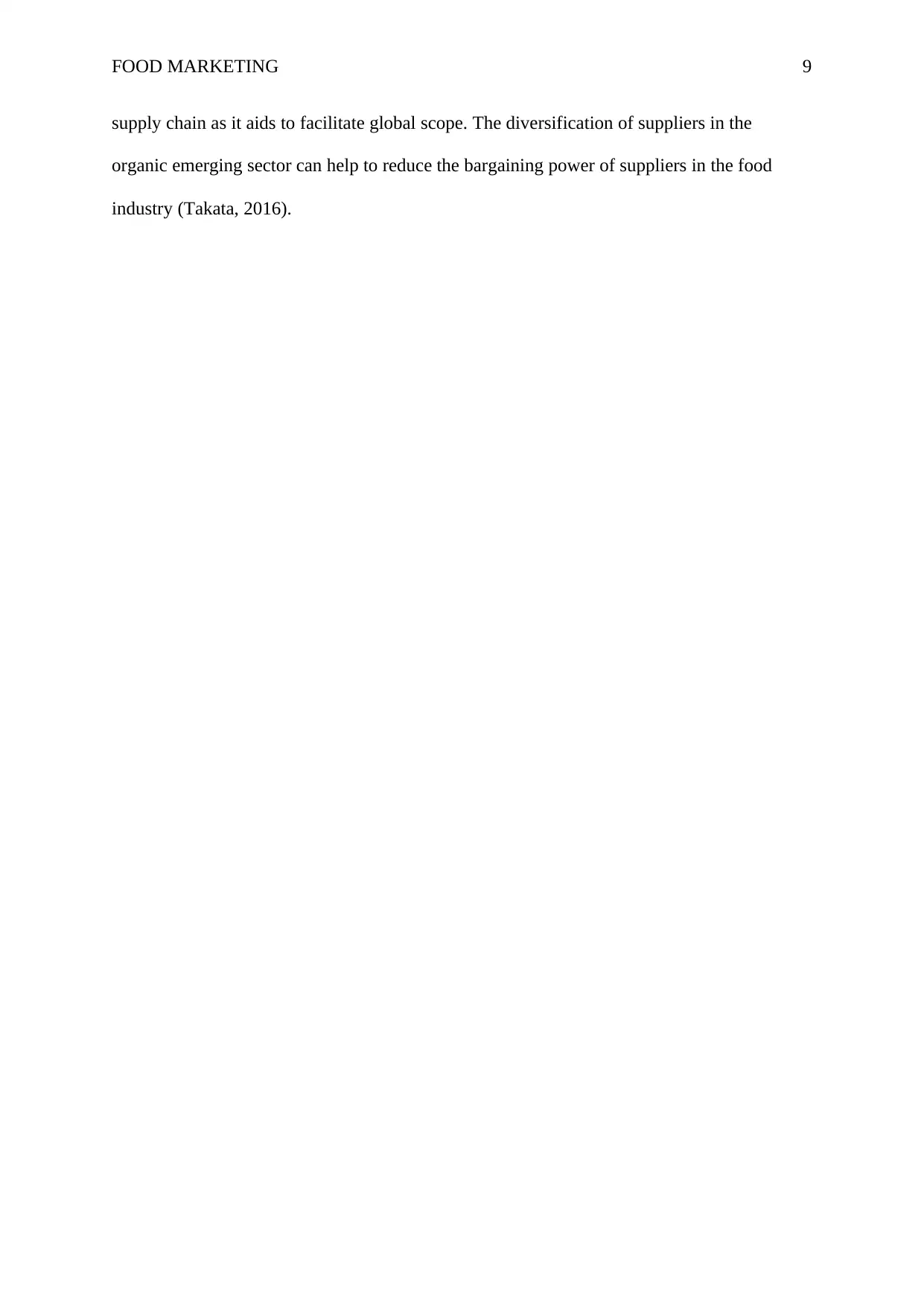
FOOD MARKETING 9
supply chain as it aids to facilitate global scope. The diversification of suppliers in the
organic emerging sector can help to reduce the bargaining power of suppliers in the food
industry (Takata, 2016).
supply chain as it aids to facilitate global scope. The diversification of suppliers in the
organic emerging sector can help to reduce the bargaining power of suppliers in the food
industry (Takata, 2016).
You're viewing a preview
Unlock full access by subscribing today!

FOOD MARKETING 10
References
Australian government., 2018. Food and Beverage. [Online]. Available at:
https://www.austrade.gov.au/International/Buy/Australian-industry-capabilities/Food-and-
Beverage (Accessed: 07 August 2018).
Australian government., 2018. Food industry. [Online]. Available at:
https://www.australia.gov.au/information-and-services/business-and-industry/food-industry
(Accessed: 07 August 2018).
Australian Institute of food safety., 2018. Food Industry Sectors in Australia. [Online].
Available at: https://www.foodsafety.com.au/resources/articles/food-industry-sectors-in-
australia (Accessed: 07 August 2018).
IBIS World., 2018. Industry Statistics & Market Size. [Online]. Available at:
https://www.ibisworld.com.au/industry-trends/market-research-reports/manufacturing/food-
product/ (Accessed: 07 August 2018).
Statista., 2018. Global Comparison – Revenue. [Online]. Available at:
https://www.statista.com/outlook/253/107/food-beverages/australia#market-globalRevenue
(Accessed: 07 August 2018).
Statista., 2018. Food & Beverages. [Online]. Available at:
https://www.statista.com/outlook/253/107/food-beverages/australia#market-revenue
(Accessed: 07 August 2018).
Takata, H., 2016. Effects of industry forces, market orientation, and marketing capabilities on
business performance: An empirical analysis of Japanese manufacturers from 2009 to 2011.
Journal of Business Research, 69(12), pp.5611-5619.
Ulubeyli, S., 2017. Industry-wide competitiveness assessment through fuzzy synthetic
evaluation: the case of the cement industry. Journal of Business Economics and Management,
18(1), pp.35-53.
References
Australian government., 2018. Food and Beverage. [Online]. Available at:
https://www.austrade.gov.au/International/Buy/Australian-industry-capabilities/Food-and-
Beverage (Accessed: 07 August 2018).
Australian government., 2018. Food industry. [Online]. Available at:
https://www.australia.gov.au/information-and-services/business-and-industry/food-industry
(Accessed: 07 August 2018).
Australian Institute of food safety., 2018. Food Industry Sectors in Australia. [Online].
Available at: https://www.foodsafety.com.au/resources/articles/food-industry-sectors-in-
australia (Accessed: 07 August 2018).
IBIS World., 2018. Industry Statistics & Market Size. [Online]. Available at:
https://www.ibisworld.com.au/industry-trends/market-research-reports/manufacturing/food-
product/ (Accessed: 07 August 2018).
Statista., 2018. Global Comparison – Revenue. [Online]. Available at:
https://www.statista.com/outlook/253/107/food-beverages/australia#market-globalRevenue
(Accessed: 07 August 2018).
Statista., 2018. Food & Beverages. [Online]. Available at:
https://www.statista.com/outlook/253/107/food-beverages/australia#market-revenue
(Accessed: 07 August 2018).
Takata, H., 2016. Effects of industry forces, market orientation, and marketing capabilities on
business performance: An empirical analysis of Japanese manufacturers from 2009 to 2011.
Journal of Business Research, 69(12), pp.5611-5619.
Ulubeyli, S., 2017. Industry-wide competitiveness assessment through fuzzy synthetic
evaluation: the case of the cement industry. Journal of Business Economics and Management,
18(1), pp.35-53.
1 out of 10
Related Documents
Your All-in-One AI-Powered Toolkit for Academic Success.
+13062052269
info@desklib.com
Available 24*7 on WhatsApp / Email
![[object Object]](/_next/static/media/star-bottom.7253800d.svg)
Unlock your academic potential
© 2024 | Zucol Services PVT LTD | All rights reserved.





